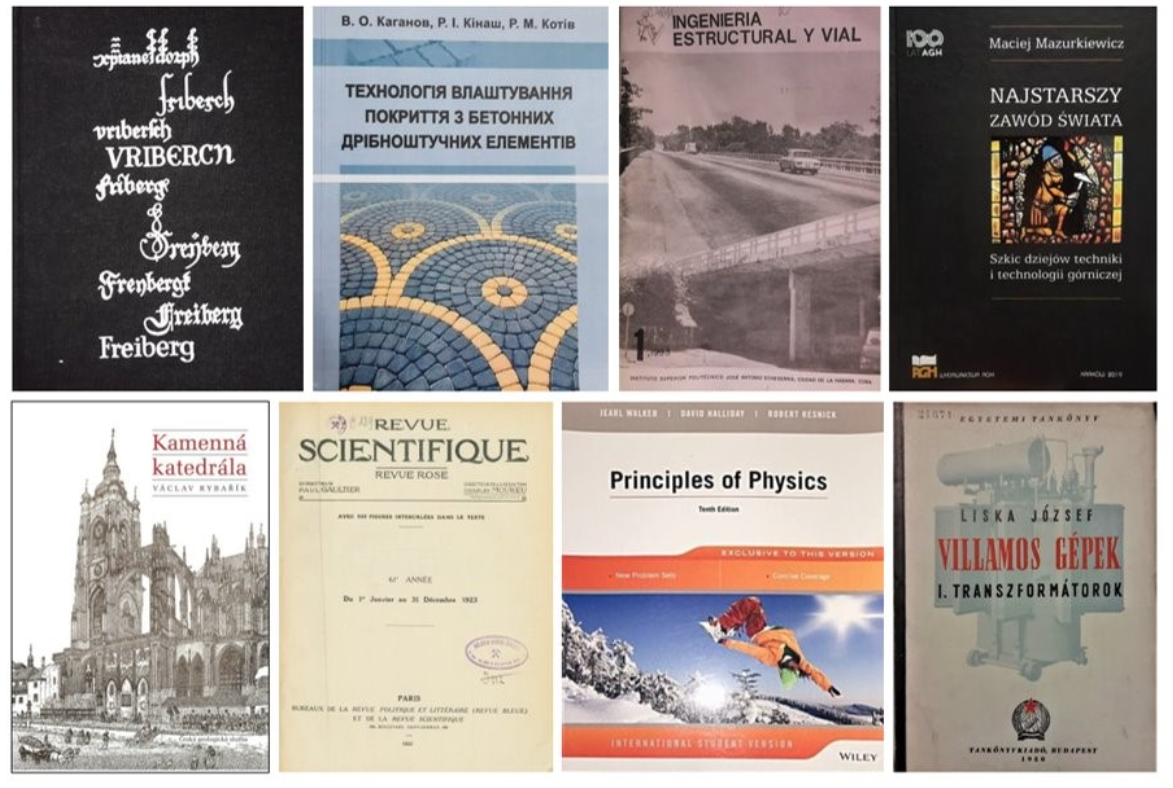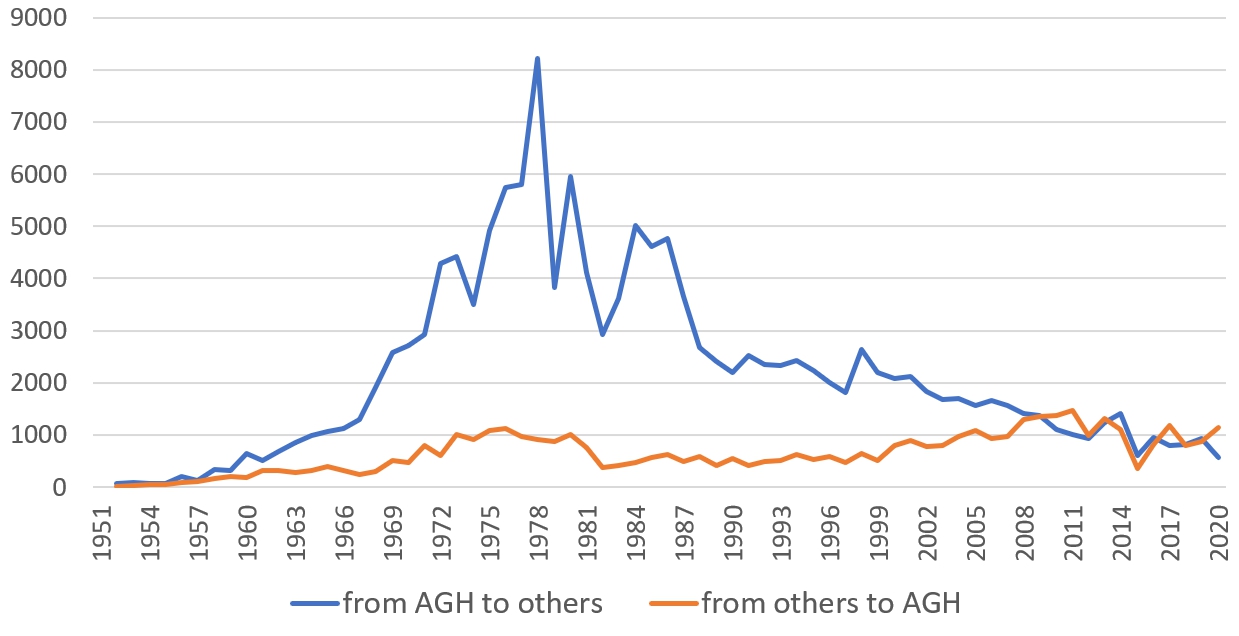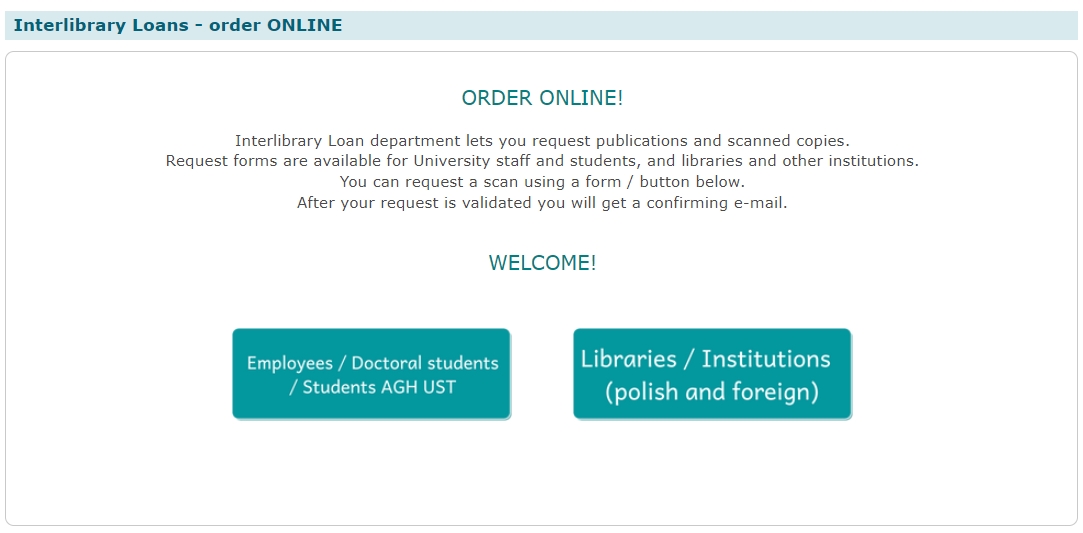International loans in the Main Library of AGH UST: The technical library as a witness of change
Karolina Forma
Abstract
Workflows and methods used in the Main Library of AGH UST changed with the challenging history of Poland and rapid changes in sourcing information for the Library’s patrons and STEM professionals. The article describes this journey specifically from the point of view of the Interlibrary Loans Department. Since 1952 it has served hundreds of thousands of users domestically and outside of Poland, maintaining continuing relationships with its partners. The most important milestone in document delivery was in 2001, when the library started using IFLA Vouchers, which made managing loans much easier. Nowadays, in times of digitization and open access ILL is still important – as its core role is providing access to materials which often can seem unobtainable.
Keywords
International library loans; Interlibrary loan; AGH UST (Krakow); AGH UST Library; Polish libraries; Data analysis
Article
History and context of the Main Library of AGH UST
The Main Library of the Academy of Mining and Metallurgy in Krakow (Akademia Górniczo–Hutnicza im. Stanisława Staszica w Krakowie)[1] opened in the academic year 1919–20, as a vital part of a new university in Krakow. The need for a technical university in the 20th century in southern Poland was urgent. So in 1912, when Krakow was still a part of the Austro-Hungarian Empire, the Ministry of Public Works in Vienna agreed to the founding of the Mining Academy. After the restoration of Poland’s sovereignty in 1918, the University was officially opened, and a library followed, in 1920. The collection was and still is very specialised: the Library holds mainly scientific works about mining, machine building, foundry, technology, and the environment – historically the most important disciplines for the University. Additionally, there are mathematics, management, and social sciences collections.
The library network consists of the Main Library and thirteen faculty libraries, two institute libraries and three libraries of non-faculty units.[2] The Library collection mirrors the needs of the Academy and has always been based on various sources and regular international exchanges. The library holds books in 50 languages.
From its very first days the Academy and the Library connected different cultures and languages, as it was founded just after the First World War, when Poland became an independent state again. Its core collection was founded by Polish professors, who were often trained abroad, speaking various languages. Furthermore, Marie Curie-Skłodowska founded the Library’s subscription of French journals, specifically Revue Scientifique, Revue Rose, and Comptes Rendus Hebdomadaires des Séances de l’Académie des Sciences (Krawczyk, 2009).
Up until 1939, the University and the Library were connected to their Austro-Hungarian roots and Upper Silesia, both receiving and lending materials – partially in German. After the Second World War Poland and all its administration were heavily influenced by the Soviet Union. As the connections to “the West” were limited, University professors had to build contacts within Poland and in the Eastern Bloc (Fig. 1).
The most important way of informing others about what the Library was holding was printed catalogues sent out to libraries in the Eastern Bloc or personal connections.
The Library was always ready for international connections, but did not always document internal affairs – so the earliest data about ILL in the Library can be found in 1951, when polyglot Zofia Żebrowska was hired to lead the Interlibrary Loans Office (Krawczyk, 2009). Internal statistical documents give us some information about the circulation of prints. In 1952, 77 publications were lent and 12 borrowed by the Library, in 1953 – 93 lent, 27 borrowed.
Circulation got larger each year, but only to and from Polish institutions. Currently, the Interlibrary Loans Office still works primarily with Polish institutions. Sources requested by our patrons can be accessed only in the scenic Main Reading Room. Services are available to the employees, doctoral students, and full-time and extramural students of AGH UST.

The first international loan took place in 1972. A professor requested a conference paper from Bergbau-Bücherei in Bochum, Western Germany, one of the oldest libraries in the Ruhr area. It was managed without payment, as the libraries were operating exclusively on mutual agreements. To this day, German libraries remain our closest partners, both lending and receiving materials.
In the 1970s, 56 international borrowings were documented. The most important partners for the AGH UST Library were European units, mostly from the Eastern Bloc although the University was developing a vast web of connections – from Japan and India to South America, due to scientific research in mining and metallurgy.
Statistics in the 1970s showed a proportion of 13:1 (when one book was lent from outside Poland, 133 were lent internally). At the end of 1979 the Library had an agreement on Interlibrary Loans with 24 libraries, some of them in our sister institutions – Technical University in Ostrava or Freiberg University.
- Kungliga biblioteket – Stockholm, Sweden
- Utrikespolitiska institutet – Stockholm, Sweden
- DTU Bibliotek – Lyngby, Sweden
- Central Scientific Library of the USSR Academy of Sciences – Kiev, then Ukrainian Soviet Socialist Republic
- Lviv Polytechnic Library – Lviv, then Ukrainian Soviet Socialist Republic
- Univerzitná Knižnica – Bratislava, then Czechoslovakia
- National Széchényi Library – Budapest, Hungary
- Österreichische Nationalbibliothek – Vienna, Austria
- Central Scientific and Technical Library – Sofia, then People’s Republic of Bulgaria
- Ústřední knihovna:Vysoká škola báňská – Ostrava, then Czechoslovakia
- Eindhoven University of Technology – Eindhoven, The Netherlands
- Universitetsbiblioteket Norges teknisk-naturvitenskapelige universitet – Trondheim, Norway
- Universitätsbibliothek – Freie Universität Berlin, then Federal Republic of Germany
- Universitätsbibliotheken TU Berlin. then Federal Republic of Germany
- Universitätsbibliothek – Technische Universität Braunschweig, then Federal Republic of Germany
- Universitätsbibliothek – TU Clausthal. then Federal Republic of Germany
- Württembergische Landesbibliothek Stuttgart, then Federal Republic of Germany
- Universitätsbibliothek Stuttgart, then Federal Republic of Germany
- Zentralbibliothek – Universität Hohenheim – Stuttgart, then Federal Republic of Germany
- Bergbau-Bücherei in Essen, then Federal Republic of Germany
- Bibliothek des Karlsruher Instituts für Technologie – Karlsruhe, then Federal Republic of Germany
- Bayerische Staatsbibliothek – Munich, then Federal Republic of Germany
- Universitätsbibliothek der Technischen Universität München – Munich, then Federal Republic of Germany
- Universitätsbibliothek TU Bergakademie Freiberg, then German Democratic Republic
The last two decades of the 20th century were characterized by the rise of electronic sources and methods. More and more requests were sent by fax and information about the Library’s holdings could increasingly be found on the internet. Librarians stopped receiving random library slips sent out by readers who needed a book but were uncertain if the Library had it. In the 1980s, requests were received from France and Soviet Union. The Library of Congress was also an important partner, lending twenty-five books, one copy of an article and one journal. The eighties also brought noteworthy political changes; changes in University administration, and consequently, changes in the Library and its international co-operations. After a dramatic period of strike-breaking and Martial Law, Poland regained its independence from soviet influence in 1989 and the transformation started. The borders opened and let in many more academics, independent education, and new sources (Fig. 2).

The 1990s was a prime time for developing further cooperation with the US – University of Illinois, The New York State Library, University of California, among many others. With the Iron Curtain falling in 1989, new possibilities arose and more contacts were managed – from Portugal, Australia, Brazil, China and South Africa. Nowadays, we are partnered with 265 libraries in 31 countries.
COVID-19 response
The Library was closed to patrons from March 16th to May 15th, 2020, due to the COVID-19 pandemic. As the world tried to manage these “unprecedented times” requests still had to be fulfilled and books had to be sent. ILL Office employees had to physically be in the workplace at least a few hours a day throughout those two months – as they were still a part of the Circulation Department which was still working, partially offline. All the safety precautions were taken, patrons weren’t allowed to enter premises and the employees tried to work in isolation.
The most important task of the Office was providing information – as many patrons contacted the Library asking about all the changes that were then happening. The Office got lots of questions by social media or bibliochat, in addition to multiple telephone calls a day.
As internal work was managed, external communication had to change. March 2020 was when online forms started to be used for ILL in the Main Library (Fig. 3). Requests subsided a lot as the library started promoting online services. Ordering online was managed via a system made for the library by Academic Computer Centre CYFRONET AGH.

All the requested printed sources were scanned. If a patron requested a book, a scan of the table of contents was sent with an inquiry about which part of the book was needed, and then only the requested part was scanned and sent. Full books are not digitized in the Interlibrary Loans Office due to copyright laws. Furthermore, patrons do not express a need for complete books, only specific chapters.
It was a trying time for loaning as many people turned to searching for resources online out of pure convenience. The pandemic brought about a serious decrease in requests – so the changes were very much needed.
The change in the Library
From its foundation up to 2021, the Interlibrary Loans Office was a part of the Circulation Department. Nowadays the Office is part of the International Cooperation and Inventory Control Division. With the new administration some methods changed – mostly in terms of communication. Online request forms were developed and the Library joined the Polish interlibrary loan system ACADEMICA.
Circulation is done online. Currently, the Library is using Virtua, but the migration to a new ILS will happen in the future. Books can be borrowed for a month, theses for two weeks, and journal issues for one week. The full process, from taking the request to completion takes a mere hour.
Electronic request forms are used for communicating online for: registering new patrons, ordering scans of journal articles or book excerpts, which are not available for loan, or ordering printouts of Polish and foreign standards, ordering magazines from the storeroom for use in the Main Reading Room, managing Interlibrary Loan Service, requesting the purchase of books for the AGH Library’s collection as well as for the Fiction Collection.
The Office has also opened to the public in a different way: Agnieszka Zych, from the Interlibrary Loans Office, is a Polish Sign Language expert and helps tremendously with the visibility of the Library and its social media.
On the other hand, we decided to continue logging the international lends on handwritten cards and yearly reports, mostly for aesthetic and historical purposes (Fig. 4).

The Library and the University
The University is home to 2,184 teachers, including sport instructors and language teachers, and 20,562 students, including doctoral students and post-grads[3]. 95% of users of the Interlibrary Loans Office are professors. The core audience is STEM professionals but the Library carries a sizeable portion of sources for the Faculty of Humanities and the Faculty of Management.
The Library doesn’t participate in many projects – as we work closely with German libraries, TIB in Hannover being one of them, we joined TIBORDER in 2000 but decided against joining SUBITO. The year after, we joined the IFLA Voucher programme. In 2015, the Library joined the Bibliotheksverbund Bayern (BVB). In 2021, we joined ACADEMICA – Interlibrary loan system of books and scientific publications, a library project by the Polish National Library in cooperation with the Foundation for Polish Science and the Research and Academic Computer Network (Academica, n.d.). The aim of the project was to introduce a new level of quality to the interlibrary loan system by replacing its traditional form of sending paper copies by post with lending publications in digital form. The project was financed by the European Union from the European Regional Development Fund under the Innovative Economy Operational Programme. The project gives its users access to more than 3.7 million publications in all fields of knowledge, including the latest, protected by copyright.
In times of digitalization and open access, ILL is still very important—as its core role is lending materials, quite often those which seem unreachable. The central idea we all agree on is reciprocity. If a partnered library offers its services for free, the Library also lends materials free of charge.
Being more open also means communicating more. So the Office took some steps to make itself more visible and accessible. Besides social media campaigns, ILL was promoted through various Open Day events in May 2022. These promotion activities revealed just how many users simply didn’t know they could use the interlibrary loan service. Many of the young people questioned said that they just didn’t want to bother the Library and preferred finding sources online.
In summary, in 50 years since its beginning, the Interlibrary Loans Office has undergone many changes due to the political climate, work methods, and circumstances. It has always served a specific clientele – professionals in need of very particular sources of information, so specific that they were unobtainable in Kraków (the city is known for its scientific prowess and creative potential). The Office changed with the Digital Revolution by scanning and sharing the unique works of the University professors and by constantly connecting with other libraries, creating new kinships.
The Library is a central part of the University, holding the vision of knowledge, passion, and affinities; everchanging, but always there.
Bibliography
Academica. Cyfrowa wypożyczalnia międzybiblioteczna książek i czasopism naukowych. (n.d.). Retrieved October 21, 2022, from https://academica.edu.pl
Akademia Górniczo-Hutnicza im. Stanisława Staszica w Krakowie. (2022). Fakty i liczby. Retrieved October 21, 2022, from https://www.agh.edu.pl/o-agh/fakty-i-liczby
Biblioteka Główna AGH. (2014). Maria Skłodowska Curie w 100-lecie otrzymania Nagrody Nobla. Retrieved October 21, 2022, from http://www.bg.agh.edu.pl/MSC/msc.php?page=01rok
Fulara, I., Zych, A., & Imiołek-Stachura, K. (2017). Międzynarodowa współpraca w zakresie wypożyczeń międzybibliotecznych – na przykładzie Wypożyczalni Międzybibliotecznej Biblioteki Głównej Akademii Górniczo-Hutniczej. Biblioteka i Edukacja, (12), 1-18. https://bazhum.pl/bib/article/578365
Krawczyk, J., Janczak, B., & Dudziak-Kowalska, M. (2009). Bibliotekarze w dziewięćdziesięcioleciu Akademii Górniczo-Hutniczej. Uczelniane Wydaw. Nauk.-Dydakt. AGH im. S. Staszica.

